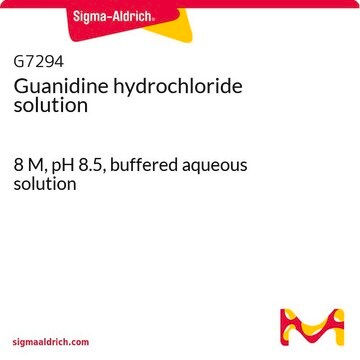50933
Guanidine hydrochloride
BioUltra, for molecular biology, ≥99.5% (AT)
Synonim(y):
Aminoformamidine hydrochloride, Aminomethanamidine hydrochloride, Guanidinium chloride
About This Item
Polecane produkty
pochodzenie biologiczne
synthetic
klasa czystości
for molecular biology
linia produktu
BioUltra
Próba
≥99.5% (AT)
Postać
powder or crystals
metody
RNA extraction: suitable
zanieczyszczenia
DNases, none detected
RNases, none detected
insoluble matter, passes filter test
phosphatases, none detected
proteases, none detected
pozostałość po prażeniu
≤0.05% (as SO4)
strata
≤0.05% loss on drying, 20 °C (HV)
kolor
colorless to white,
pH
4.5-6.0 (25 °C, 6 M in H2O)
mp
180-185 °C (lit.)
rozpuszczalność
H2O: 6 M at 20 °C, clear, colorless
gęstość
1.3 g/cm3 (lit.)
ślady anionów
sulfate (SO42-): ≤50 mg/kg
ślady kationów
Al: ≤5 mg/kg
As: ≤0.1 mg/kg
Ba: ≤5 mg/kg
Bi: ≤5 mg/kg
Ca: ≤10 mg/kg
Cd: ≤5 mg/kg
Co: ≤5 mg/kg
Cr: ≤5 mg/kg
Cu: ≤5 mg/kg
Fe: ≤5 mg/kg
K: ≤50 mg/kg
Li: ≤5 mg/kg
Mg: ≤5 mg/kg
Mn: ≤5 mg/kg
Mo: ≤5 mg/kg
Na: ≤150 mg/kg
Ni: ≤5 mg/kg
Pb: ≤5 mg/kg
Sr: ≤5 mg/kg
Zn: ≤5 mg/kg
ciąg SMILES
Cl[H].NC(N)=N
λ
6 M in H2O
absorpcja UV
λ: 260 nm Amax: 0.03
λ: 280 nm Amax: 0.02
temp. przechowywania
room temp
InChI
1S/CH5N3.ClH/c2-1(3)4;/h(H5,2,3,4);1H
Klucz InChI
PJJJBBJSCAKJQF-UHFFFAOYSA-N
informacje o genach
human ... KCNA1(3736) , KCNA10(3744) , KCNA2(3737) , KCNA3(3738) , KCNA4(3739) , KCNA5(3741) , KCNA6(3742) , KCNA7(3743) , KCNB1(3745) , KCNB2(9312) , KCNC1(3746) , KCNC2(3747) , KCNC3(3748) , KCNC4(3749) , KCND1(3750) , KCND2(3751) , KCND3(3752) , KCNF1(3754) , KCNG1(3755) , KCNG2(26251) , KCNG3(170850) , KCNG4(93107) , KCNH1(3756) , KCNH2(3757) , KCNH3(23416) , KCNH4(23415) , KCNH5(27133) , KCNH6(81033) , KCNH7(90134) , KCNH8(131096) , KCNQ1(3784) , KCNQ2(3785) , KCNQ3(3786) , KCNQ4(9132) , KCNQ5(56479) , KCNS1(3787) , KCNS2(3788) , KCNS3(3790) , KCNV1(27012) , KCNV2(169522)
Szukasz podobnych produktów? Odwiedź Przewodnik dotyczący porównywania produktów
Opis ogólny
Zastosowanie
Działania biochem./fizjol.
Hasło ostrzegawcze
Warning
Zwroty wskazujące rodzaj zagrożenia
Zwroty wskazujące środki ostrożności
Klasyfikacja zagrożeń
Acute Tox. 4 Inhalation - Acute Tox. 4 Oral - Eye Irrit. 2 - Skin Irrit. 2
Kod klasy składowania
11 - Combustible Solids
Klasa zagrożenia wodnego (WGK)
WGK 1
Temperatura zapłonu (°F)
Not applicable
Temperatura zapłonu (°C)
Not applicable
Środki ochrony indywidualnej
dust mask type N95 (US), Eyeshields, Faceshields, Gloves
Certyfikaty analizy (CoA)
Poszukaj Certyfikaty analizy (CoA), wpisując numer partii/serii produktów. Numery serii i partii można znaleźć na etykiecie produktu po słowach „seria” lub „partia”.
Masz już ten produkt?
Dokumenty związane z niedawno zakupionymi produktami zostały zamieszczone w Bibliotece dokumentów.
Klienci oglądali również te produkty
Produkty
A RPLC-MS workflow for mass analysis of reduced monoclonal antibody, trastuzumab, including reduction procedures, calibration, and system suitability tests.
A RPLC-MS workflow for mass analysis of non-reduced monoclonal antibody, trastuzumab, including calibration, and system suitability tests.
Protokoły
A complete workflow for the intact and middle-up mass analysis of reduced and non-reduced monoclonal antibodies based on SEC-MS with sample preparation by protein-A affinity clean-up.
A step-by-step protocol for released N-linked glycan analysis of the monoclonal antibody adalimumab, based on UHPLC-FLR-MS and procainamide labeling.
Powiązane treści
Overview of common techniques and downstream applications for extraction and purification of genomic DNA, plasmid DNA, and total RNA from cells, tissue, blood, viruses, and other sample types.
Przegląd powszechnych technik i dalszych zastosowań do ekstrakcji i oczyszczania genomowego DNA, plazmidowego DNA i całkowitego RNA z komórek, tkanek, krwi, wirusów i innych rodzajów próbek.
Nasz zespół naukowców ma doświadczenie we wszystkich obszarach badań, w tym w naukach przyrodniczych, materiałoznawstwie, syntezie chemicznej, chromatografii, analityce i wielu innych dziedzinach.
Skontaktuj się z zespołem ds. pomocy technicznej


